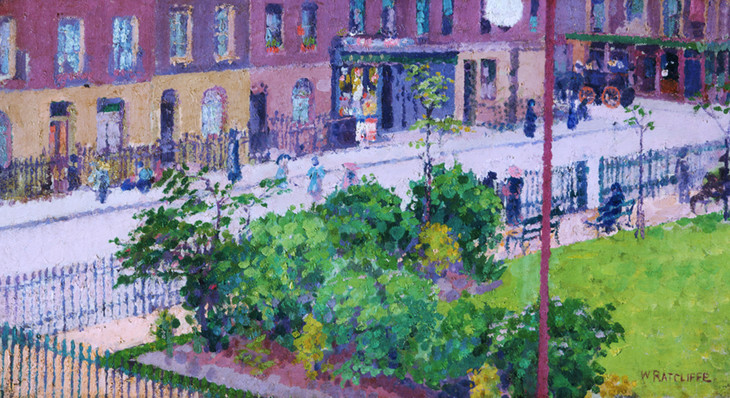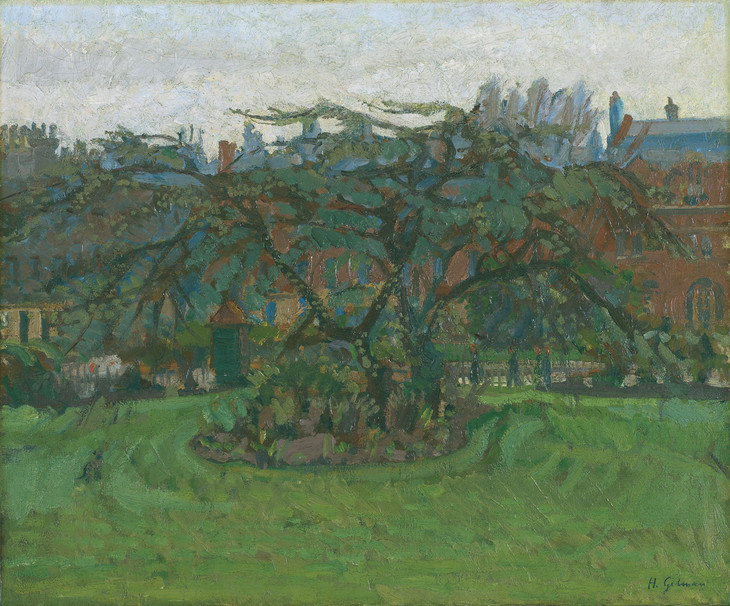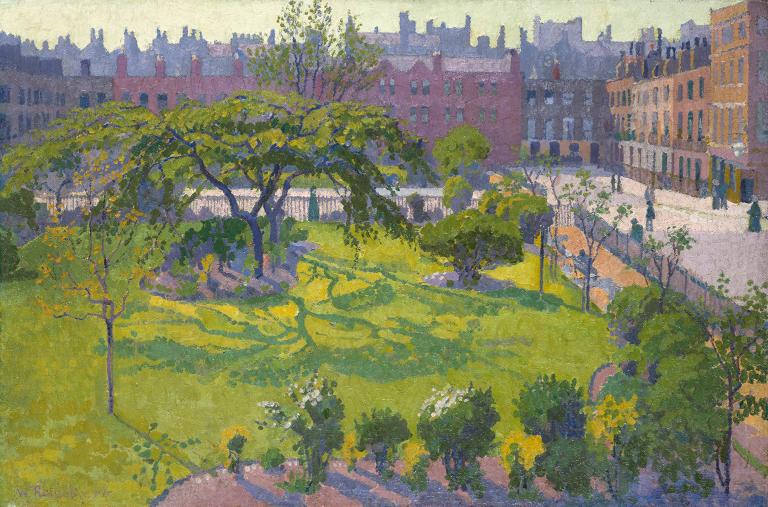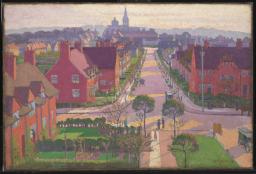William Ratcliffe Clarence Gardens 1912
© The estate of William Ratcliffe
William Ratcliffe,
Clarence Gardens
1912
© The estate of William Ratcliffe
The organic form of the tree casting its shadow over the brilliant green grass in the middle ground provides a strong contrast to the neat geometries of the shining road surface and background row of houses in Ratcliffe’s picture. Diminutive pedestrian figures move along the pavement on the right-hand side. Ratcliffe painted few central London scenes and was probably inspired by his friend Harold Gilman, who made two pictures of the same square.
William Ratcliffe 1870–1955
Clarence Gardens
1912
Oil paint on canvas
508 x 762 mm
Inscribed ‘W. Ratcliffe 1912’ bottom left
Purchased 1982
T03359
1912
Oil paint on canvas
508 x 762 mm
Inscribed ‘W. Ratcliffe 1912’ bottom left
Purchased 1982
T03359
Ownership history
... ; acquired from Roland, Browse and Delbanco, London, by the Contemporary Art Society 1946, by whom given to the Russell-Cotes Art Gallery and Museum, Bournemouth 1946; their sale, 14 October 1959, Knight, Frank and Rutley (49, as ‘A London Square’), where bought for £2 by Holder; ... ; Mr and Mrs David Drown; Anthony d’Offay Gallery, London, by 1979, from whom bought by Tate Gallery 1982.
Exhibition history
1912
The London Salon of the Allied Artists’ Association Ltd, Royal Albert Hall, London, July 1912 (?187 or 188).
1912
?The Camden Town Group, Carfax Gallery, London, December 1912 (42, as ‘Clarence Gardens’, 15 guineas).
1914
?Twentieth Century Art, Whitechapel Art Gallery, London, May 1914 (?20 or 420).
1979
Paintings of London by Members of the Camden Town Group, Anthony d’Offay Gallery, London, October–November 1979 (29).
1990
London’s Pride: The Glorious History of the Capital’s Gardens, Museum of London, May–August 1990 (no number).
2002
Harold Gilman and William Ratcliffe, Southampton City Art Gallery, April–July 2002 (no number, reproduced p.17).
2008
Modern Painters: The Camden Town Group, Tate Britain, London, February–May 2008 (27, reproduced).
References
1912
Sir Claude Phillips, ‘The Camden Town Group’, Daily Telegraph, 17 December 1912, p.14.
1922
Drawing and Design, no.22, February 1922, reproduced p.756, as A London Square.
1979
Wendy Baron, The Camden Town Group, London 1979, pp.45–6, 322, reproduced p.323.
1979
Christopher Neve, ‘Everyday London Revisited: The View from Camden Town’, Country Life, vol.166, no.4297, 15 November 1979, p.1735, reproduced fig.6.
1980
Simon Watney, English Post-Impressionism, London 1980, p.71, reproduced pl.59.
1982
William Ratcliffe, exhibition catalogue, Letchworth Museum and Art Gallery 1982, p.6.
1986
Tate Gallery Acquisitions 1982–4, London 1986, p.310, reproduced.
1988
The Painters of Camden Town 1905–1920, exhibition catalogue, Christie’s, London 1988, p.149.
2002
Richard Shone, ‘Southampton: Harold Gilman and William Ratcliffe’, Burlington Magazine, vol.144, no.1192, July 2002, p.443, reproduced fig.59.
Technique and condition
Clarence Gardens is painted on a stretched and primed canvas. Prior to Tate’s acquisition the canvas was lined to stabilise the structure of the painting. The lining consists of a coarser linen canvas stuck to the back of the original canvas with a wax-resin adhesive. The lined canvas is attached to the stretcher with coated-steel tacks. The stretcher, which consists of four pine members with expansion joints, appears old and may be the original, reused after lining.
The original canvas is one piece of linen of close plain weave, which has been prepared with sizing and a thin layer of white primer that does not extend onto the tacking edges of the stretched canvas. The priming is only visible in a few gaps at the boundaries of shapes and within broken brushstrokes of paint. It has the appearance of a lean and absorbent primer that partially fills the troughs in the canvas weave leaving a smooth textured painting surface and has all the characteristics of being prepared by the artist.
There is little visible evidence of preliminary drawing; the few broken, bright blue paint lines that are visible directly on the priming are probably the initial statement of the composition. Most of the drawing is continuous with the rest of the paint work and occurs at all levels of the work. The oil paint is applied in thick but malleable opaque colour brushed within predetermined forms. The accumulation of layers forms a substantial paint film across the surface and creates ridges of paint at the boundaries between forms. The order in which paint was applied is clearly visible in the layering. The paint was sufficiently fluid to allow distinct variations in handling from one area to another in response to the forms depicted. The accumulated slabs of colour describing the distant buildings are in contrast to the far more cursive and expressive handling of the foliage and grass. Although most forms are contained within clearly demarcated shapes, the use of outlines is restrained and bold linear work is reserved to describe the sinuous trunks and branches of the trees.
The colour scheme is dominated by contrasting greens with violets and purples ranging from unmodified hues to subtle tints and shades of grey. Only the sun yellow of the sky and pinks of the bright surface of the reflective road stand in stark tonal contrast to the mid-tones of the gardens and their surroundings. The overall effect creates an integration of natural and man-made forms through colour, light and shadow. The focus is fairly even across the whole picture with no sketchy passages or areas constrained by excessive finish and detail. The painting was varnished after it was lined but it is not known whether it was originally varnished by the artist.
Roy Perry
March 2004
How to cite
Roy Perry, 'Technique and Condition', March 2004, in Robert Upstone and Ysanne Holt, ‘Clarence Gardens 1912 by William Ratcliffe’, catalogue entry, January 2011, in Helena Bonett, Ysanne Holt, Jennifer Mundy (eds.), The Camden Town Group in Context, Tate Research Publication, May 2012, https://wwwEntry
Originally known as Clarence Market, Clarence Gardens NW1 was designed by the architect John Nash (1752–1835) as part of a series of three markets in the area to the east of Regent’s Park. Consisting of York, Cumberland and Clarence Markets, they were originally intended for trading in meat, hay and vegetables respectively. Each was bordered by terraces of small houses intended for artisan dwellers. Clarence Market was renamed Clarence Gardens soon after it was built in 1824, when the centre of the square was occupied by a market garden. The whole area was badly bombed in 1941, and Clarence Gardens was cleared and replaced by council flats in the 1960s.1

William Ratcliffe 1870–1955
Clarence Gardens c.1911–12
Oil paint on canvas
266 x 502 mm
Southampton City Art Gallery
© Estate of William Ratcliffe
Courtesy of Wendy Baron. © Southampton City Art Gallery, Hampshire, UK / The Bridgeman Art Library
Fig.1
William Ratcliffe
Clarence Gardens c.1911–12
Southampton City Art Gallery
© Estate of William Ratcliffe
Courtesy of Wendy Baron. © Southampton City Art Gallery, Hampshire, UK / The Bridgeman Art Library
Out of two in themselves fairly prosaic scenes, ‘Clarence Gardens’ and ‘Hotel Cecil from Hungerford Bridge,’ Mr. W. Ratcliffe has without offending against the modesty of truth, extracted elements of beauty. In both cases compositions of decorative aspect and satisfying harmony, both linear and chromatic, have been obtained.2
Ratcliffe may have been stimulated to make these works by his friendship with Harold Gilman, who also painted two pictures of the square around 1912 (fig.2). Although depictions of north London squares and the backs of houses were a key feature of Camden Town painting – of Gore and Gilman in particular – they represent a relatively small part of Ratcliffe’s output. For the most part the artist favoured interior scenes or landscapes and rural subjects, like those he produced in Letchworth Garden City and in Sweden, where he travelled in 1913.

Harold Gilman 1876–1919
Clarence Gardens N.W. c.1912
Oil paint on canvas
510 x 610 mm
Ferens Art Gallery, Hull
Photo © Ferens Art Gallery: Hull Museums
Fig.2
Harold Gilman
Clarence Gardens N.W. c.1912
Ferens Art Gallery, Hull
Photo © Ferens Art Gallery: Hull Museums
Robert Upstone and Ysanne Holt
January 2011
Notes
Related biographies
Related essays
- A History of Camden Town 1895–1914 David Hayes
Related catalogue entries
Related reviews and articles
- Sir Claude Phillips, ‘The Camden Town Group’ The Daily Telegraph, 17 December 1912, p.14.
How to cite
Robert Upstone and Ysanne Holt, ‘Clarence Gardens 1912 by William Ratcliffe’, catalogue entry, January 2011, in Helena Bonett, Ysanne Holt, Jennifer Mundy (eds.), The Camden Town Group in Context, Tate Research Publication, May 2012, https://www




